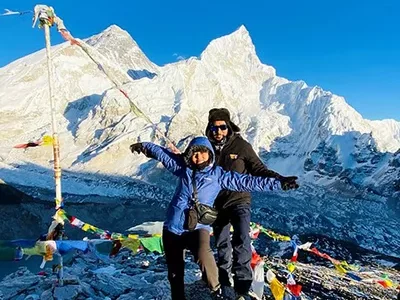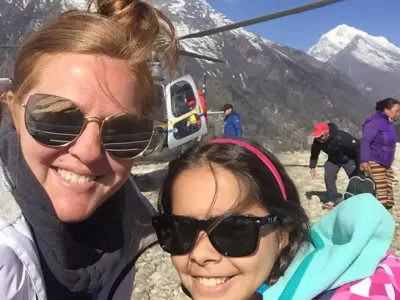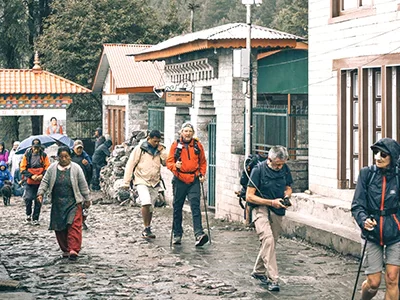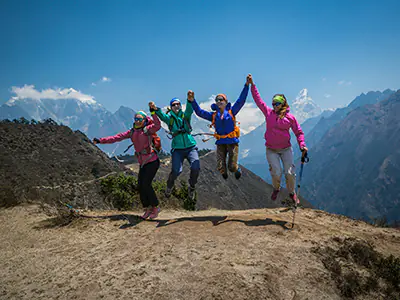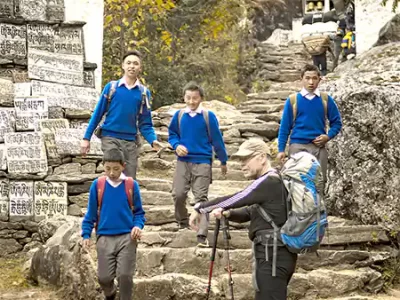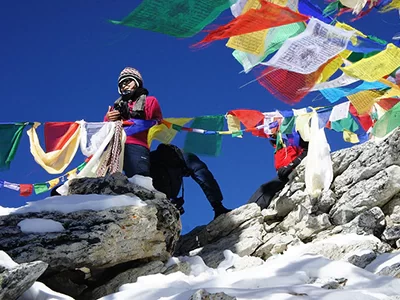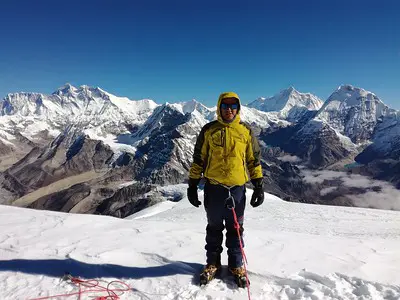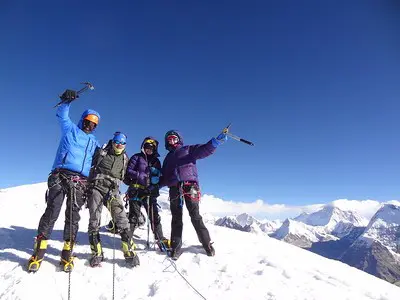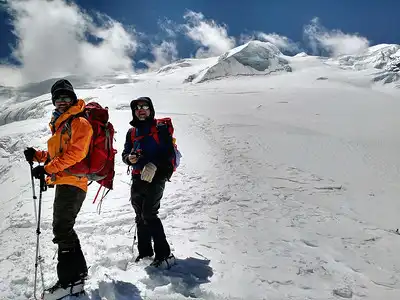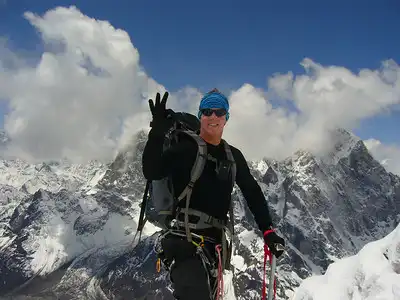The Khumbu region, blessed with a landscape that will leave one awestruck, is situated in the northeast of Nepal amidst the towering peaks of the Himalayas at its center. The Khumbu area, a jalousie destination for skilled people who have challenged their shoestrings to the limit by tackling its high rocky ridges like Mount Everest or Nuptse, is a prime pick for climbers and trekkers throughout the world due to its incredible scenery, abundance of cultures, and challenging trekking routes.
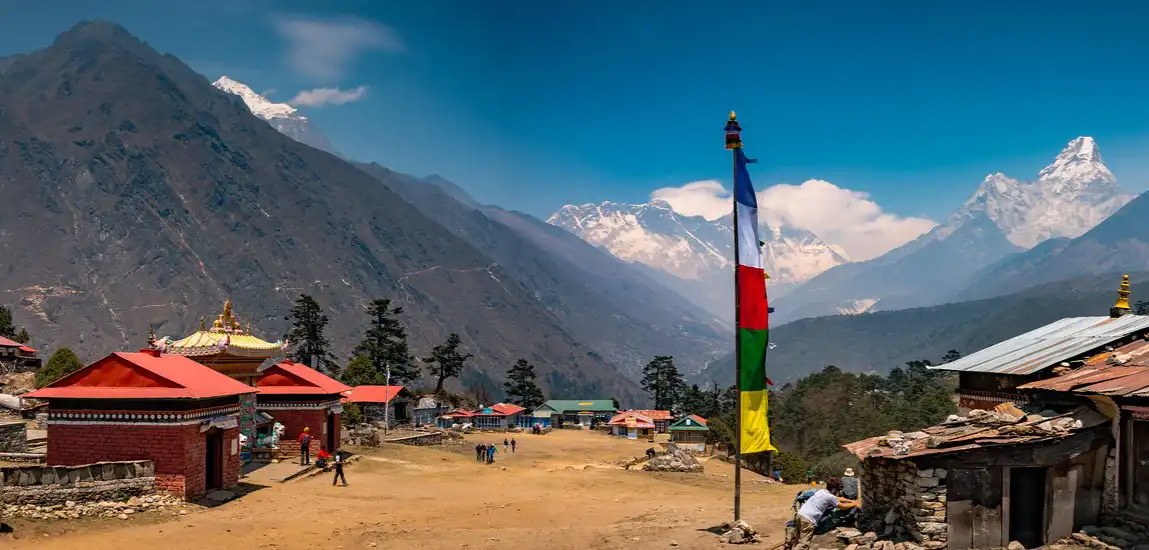
While commonly referred to as the Everest region, the Khumbu region is located within the Nepali district of Solukhumbu. This magical place is home to some top mountain ranges, such as Mount Everest, Lhotse, Nuptse, and Ama Dablam. This fascinating region has breathtaking valleys, ice fields, rivers, and real-life Sherpa villages, which provide an excellent combination of beauty and tradition.
Khumbu Region: The Path to the Peak
- Your Gateway to Mount Everest: The Khumbu region is the primary access point to Mount Everest, the planet’s highest summit. The region’s challenging paths, notably the renowned Everest Base Camp trek, draw in countless trekkers annually who yearn to experience Everest’s grandeur firsthand. A Khumbu region map is an essential tool for navigating the region’s varied terrain and reaching the base of this iconic mountain.
- Everest Base Camp Trek: The trek to Everest Base Camp offers explorers an unforgettable trek through the heart of Khumbu. Trekkers can see beautiful mountains, learn about Sherpa people, and go to the bottom of Mount Everest.
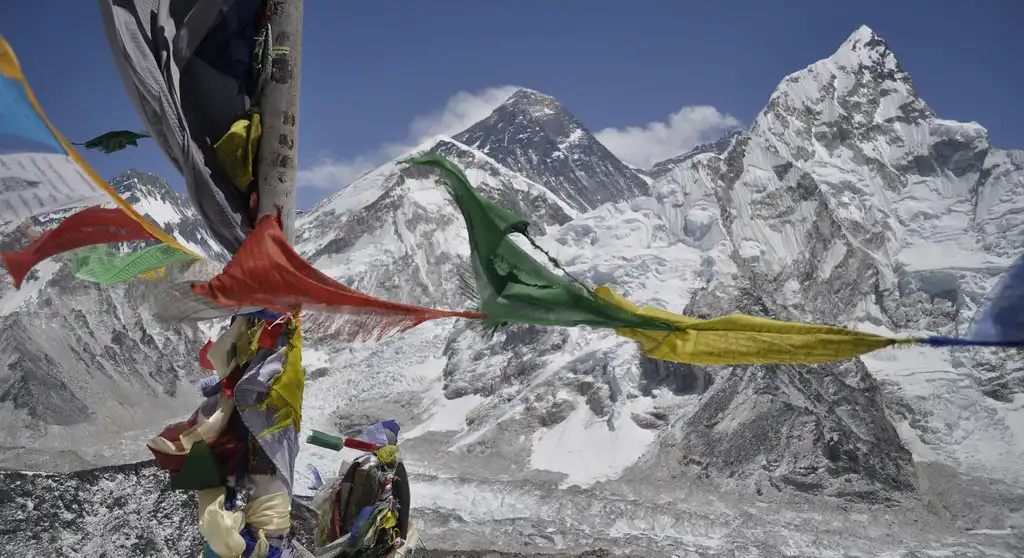
Due to its elevation, this trek challenges trekkers, requiring extensive preparation and acclimatization beforehand. Nevertheless, nothing can compare with what one stands to gain at the end of it all.
- A Legacy in Mountaineering History: The Khumbu region has shaped mountaineering history. It has witnessed numerous expeditions and attempts to conquer Mount Everest, advancing mountaineering techniques and inspiring generations of climbers. The region’s challenging peaks continue to lure experienced mountaineers eager to test their skills and push their boundaries.
Cultural Richness of the Sherpa People
- Home to the Sherpa People: The Khumbu region is the ancestral home of the Sherpa people, an ethnic group renowned for their mountaineering skills, resilience, and strong bond with the mountains. The Sherpas have been instrumental in the success of countless Everest expeditions, serving as guides, porters, and companions to climbers.
- Vibrant Cultural Traditions: The Sherpa people possess a rich cultural heritage deeply entwined with Buddhism. Their traditions, encompassing colorful festivals, monasteries, and prayer flags, add a unique layer to the Khumbu region’s allure. Visitors can experience Sherpa hospitality, witness traditional dances, and delve into their distinctive way of life.
- Guardians of the Mountains: The Sherpas view mountains as hallowed beings. They have developed ways of living for sustainability to protect this fragile ecosystem in Khumbu for their descendants. Tourists should practice responsible tourism and respect the local culture and environment.
Everest Base Camp Trek
Everest Base Camp Trek with Helicopter Return
Luxury Everest Base Camp Trek
Exploring the Geography and Topography of the Khumbu Region
Nestled in Nepal’s northeastern corner, the Khumbu Region Nepal showcases stark contrasts, where towering peaks pierce the sky, and glaciers carve paths through ancient valleys. This awe-inspiring landscape, a testament to nature’s raw power, sets the stage for some of the world’s most legendary treks and mountaineering expeditions.
High-Altitude Valleys: Nature’s Masterpiece
- Khumbu Valley: Also called the Everest Valley, this picturesque valley forms the heart of the Khumbu region.
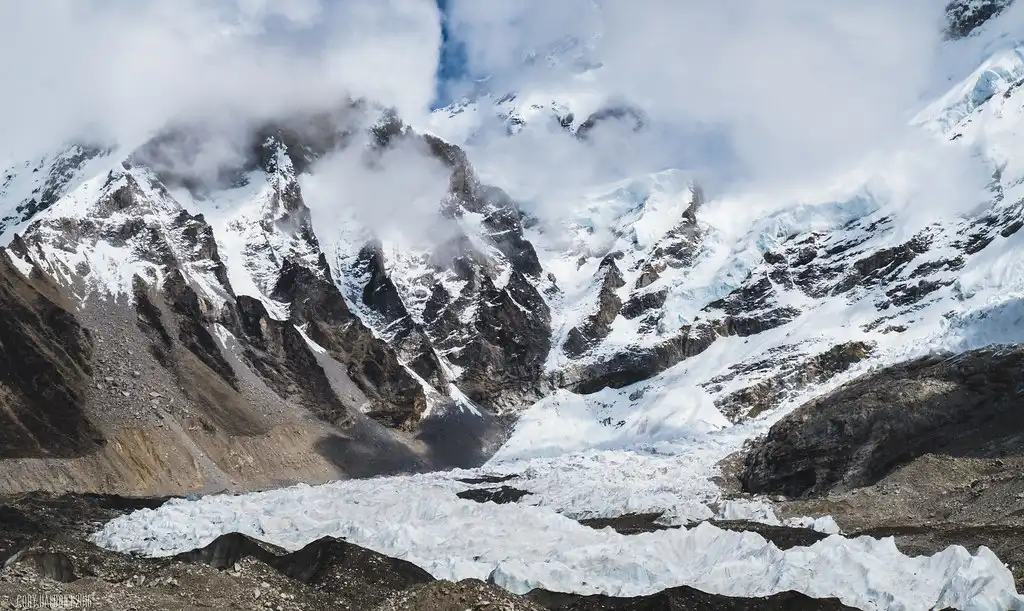
Sculpted by the Khumbu Glacier, it showcases a mesmerizing tapestry of vibrant green meadows, terraced fields, and traditional Sherpa villages. Prayer flags, mani walls, and chortens dot the valley floor, adding a touch of spiritual tranquility to the scene.
- Gokyo Valley: Situated to the west of the Khumbu Valley, Gokyo Valley offers a more secluded and serene trekking experience. This valley houses a series of captivating turquoise lakes, including Gokyo Lake, and presents breathtaking views of Cho Oyu, the world’s sixth-highest mountain.
- Thame Valley: East of Namche Bazaar lies a less-traveled valley celebrated for its traditional Sherpa villages and ancient monasteries.
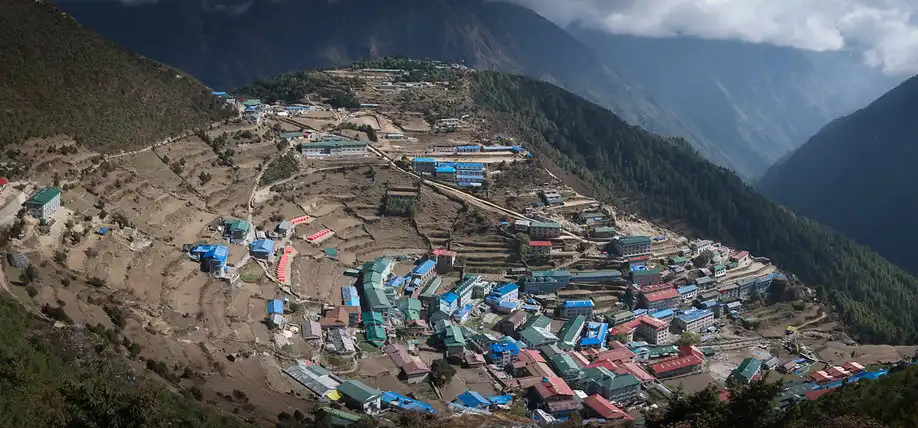
It offers a glimpse into the authentic Sherpa lifestyle and provides a peaceful haven away from the busier trekking routes.
Majestic Peaks: Reaching for the Heavens
- Mount Everest: The crown jewel of the Khumbu region, Mount Everest, stands tall at an impressive 8,848 meters (29,029 feet) and claims the title of the highest point on Earth. The summit, frequently shrouded in snow and clouds, has captivated the imaginations of adventurers for centuries.
- Lhotse: The fourth-highest mountain globally, Lhotse shares a ridge with Everest and poses a formidable challenge even to the most seasoned climbers.
- Ama Dablam: Many call Ama Dablam the “Matterhorn of the Himalayas,” celebrating its striking beauty and unique pyramid shape. It’s a favored destination for both trekking and climbing expeditions.
- Other Noteworthy Peaks: The Khumbu region boasts an array of other impressive peaks, including Nuptse, Pumori, Cho Oyu, and Makalu. Each presents unique challenges and rewards for mountaineers.
Glaciers and Icefalls: Rivers of Ice
- Khumbu Glacier: This enormous glacier, one of the largest in the Himalayas, flows down from the slopes of Everest and Lhotse to define the landscape of Khumbu Valley. The treacherous landscape it offers trekkers takes form through shifting ice formations and gaps called crevasses.
- Khumbu Icefall: Situated at the head of the Khumbu Glacier, the Khumbu Icefall is a challenging maze of towering ice pinnacles, deep crevasses, and constantly shifting ice blocks. Climbers consider it one of the most dangerous sections of the Everest climb, demanding skilled navigation and meticulous ropework.
Trekking in the Khumbu Region: A Himalayan Adventure
The Khumbu Region boasts some of the world’s best trekking paths. Be it for a beginner or experienced hiker, everyone can find something they like in Khumbu Valley, from the famous Everest Base Camp trek, the idyllic Gokyo Lakes trek, or the daunting Three Passes walk.
Popular Trekking Routes in the Khumbu Region
- Everest Base Camp Trek: This world-renowned trek takes you through the heart of Khumbu, offering stunning views of Everest, Lhotse, Nuptse, and Ama Dablam. You will experience the unique Sherpa culture, visit ancient monasteries, and stand in awe at the base of the world’s highest mountain.
- Gokyo Lakes Trek: If you seek tranquility and breathtaking scenery, the Gokyo Lakes trek is perfect.
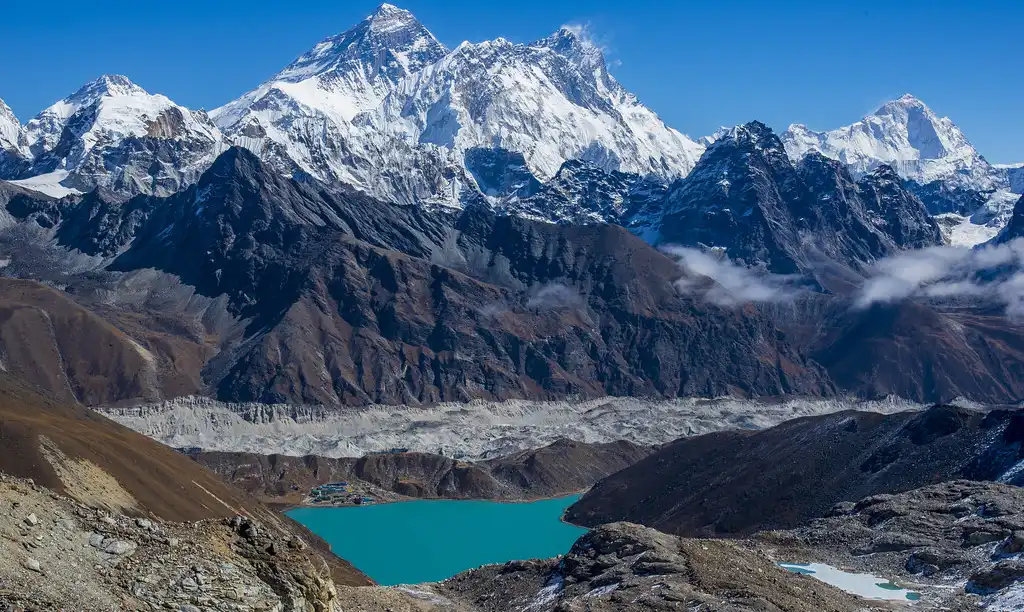
This trek leads you to pristine turquoise lakes, offering panoramic views of the Himalayas, including Cho Oyu. It’s a less crowded alternative to the Everest Base Camp trek, providing a more intimate experience with nature.
- Three Passes Trek: This challenging trek is for experienced trekkers seeking adventure and breathtaking high-altitude scenery. Crossing three high passes, Renjo La, Cho La, and Kongma La, it offers unparalleled views of Everest, Lhotse, Makalu, and other majestic peaks. It’s a physically demanding trek that rewards you with an unforgettable experience.
Key Villages and Stops Along the Way
- Namche Bazaar: Nepal’s Khumbu region begins at Namche Bazaar. Sherpas populate it, and it offers breathtaking views of Mount Everest. This area has many lodges, restaurants, and shops, making it essential for acclimatization.
- Tengboche: Home to the Tengboche Monastery, one of the most important Buddhist monasteries in the region, Tengboche is a spiritual and cultural hub.
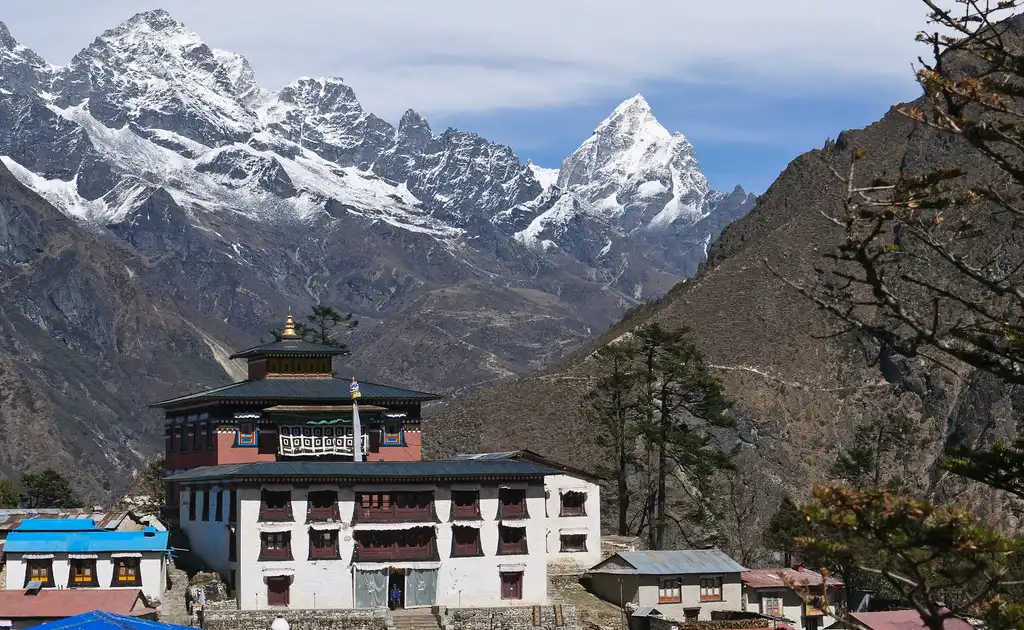
The monastery’s location offers panoramic views of Everest, Ama Dablam, and other peaks.
- Dingboche: Another crucial acclimatization stop, Dingboche is surrounded by breathtaking scenery.
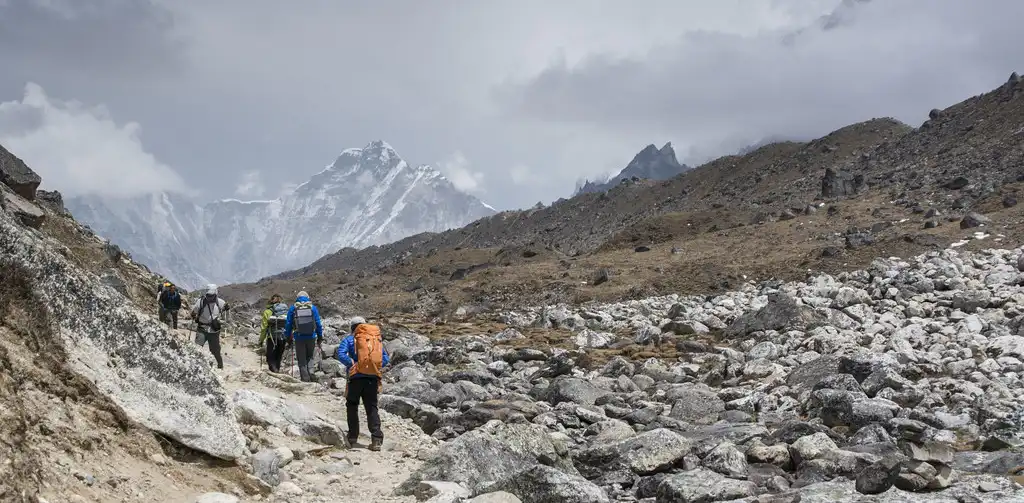
You can hike to nearby viewpoints like Nangkartshang Peak or the Imja Valley.
- Lobuche: The final stop before Everest Base Camp, Lobuche offers close-up views of the Khumbu Glacier and the Khumbu Icefall. It’s a challenging but rewarding trek, with stunning scenery at every turn.
Best Time to Trek and Difficulty Levels
- Best Time: For the Khumbu region, spring (March-May) and autumn (September-November) are the ideal trekking periods. These months usually feature clear skies, stable weather patterns, and temperate conditions.
- Difficulty Levels: The Everest Base Camp trek is moderately suitable for trekkers with reasonable fitness levels. The Gokyo Lakes trek is also moderate, with some challenging sections. The Three Passes trek is strenuous and requires prior high-altitude trekking experience.
Everest Base Camp Trek for Beginners
Everest Panorama Trek
Everest High Pass Trek
Sherpa Culture in the Khumbu Region: A Tapestry of Tradition and Adaptation
The Khumbu region of Nepal has a stunning nature, but it’s also flourishing in Sherpa Culture. You can also see a way of living that has survived these hills for ages.
The Heritage Sherpa Life: Tough Spirit
- The Sherpas, as mountain people, are renowned mountaineers, demonstrating remarkable endurance in the barren heights. Such mountain-loving individuals have their lives revolving around farming, and religion imbued with mountaineers’ essence.
- Associations and Kinships: strong family ties bind all its members in this kind of society, making them unique among other societies within Khumbu, where they rely on agriculture, domesticated animals, and commerce for survival.
- Tibetan Buddhism provides a foundation upon which Sherpa culture rests; it informs their worldview and shapes daily rituals and functions. Prayer flags drift in the wind, mani walls cover trails, and monasteries like Tengboche continue serving as spiritual lighthouses for society.
Tengboche Monastery: A Spiritual Haven
- Spiritual Significance: Tengboche Monastery, perched majestically on a hilltop overlooking the valley, commands reverence as one of the region’s most significant Buddhist monasteries. It’s a pilgrimage site for Sherpas and visitors, offering a tranquil space for meditation and introspection.
- Mani Rimdu Festival: The monastery comes alive yearly with the Mani Rimdu festival, a vibrant celebration of Sherpa culture and faith. Masked dances, prayers, and blessings fill the air, creating a unique and unforgettable experience for fortunate attendees.
- Guardians of Tradition: Tengboche Monastery is crucial in safeguarding Sherpa’s cultural heritage. Monks actively teach young Sherpas about their traditions, ensuring their unique way of life thrives for future generations.
Tourism’s Impact: Navigating Change
- Economic Opportunities: Tourism has ushered in significant financial benefits for the Khumbu, providing Sherpas with alternative income streams and raising their standard of living. Many Sherpas now work as guides, porters, and lodge owners, contributing to the flourishing trekking industry.
- Cultural Preservation Challenges: While tourism has brought economic prosperity, it has also introduced challenges to Sherpa culture. The influx of visitors has led to the adoption of Western influences, raising concerns about the potential erosion of traditional values and practices.
- Sustainable Tourism: Many Sherpas recognize the importance of preserving their cultural heritage and environment. They actively champion sustainable tourism practices, encouraging visitors to respect their traditions, minimize their environmental footprint, and support local businesses.
Exploring the Wild Heart of the Khumbu Region: A Biodiversity Hotspot
Shielded by the lofty Himalayas, the Khumbu Region is a paradise for trekkers and a colorful sanctuary for various animals and plants. This region has multiple forms of nature’s wealth, from the rare snow leopard to the vibrant rhododendron woods.
Wildlife Encounters: Witness Nature’s Wonders
- Snow Leopard: The elusive snow leopard, often called the “ghost of the mountains,” is the apex predator in the Khumbu. Though sightings are rare, their presence adds mystery to the high-altitude landscape.
- Himalayan Tahr: These nimble mountain goats, sporting their characteristic curved horns, are a frequent sight along the trails. Watch for them gracefully navigating the rugged terrain.
- Musk Deer: Shy and elusive, these creatures inhabit the dense forests of the Khumbu. Unfortunately, their musk glands, highly valued in traditional medicine, make them a target for poachers, underscoring the critical need for conservation efforts.
- Red Panda:
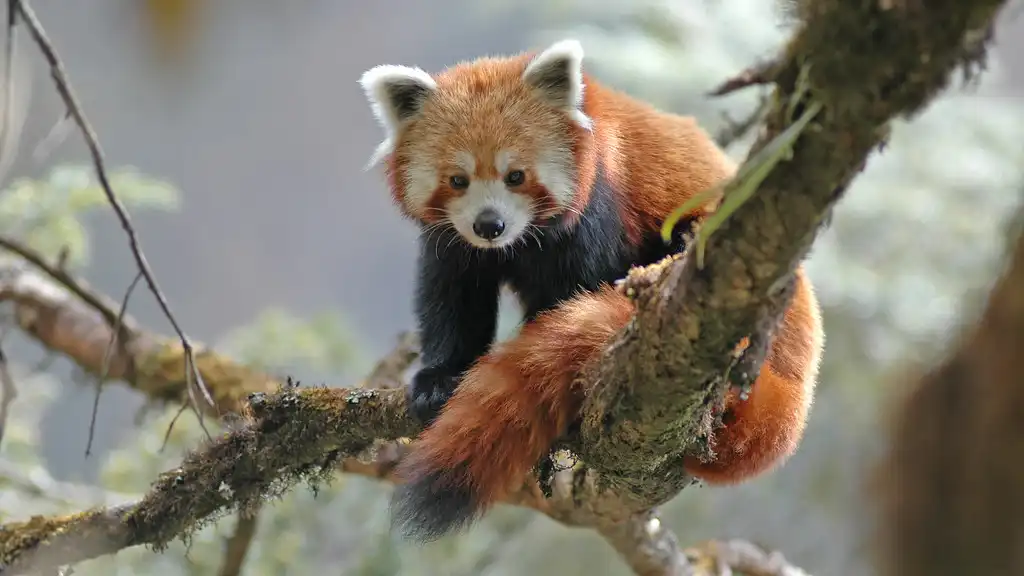
The red panda, with its adorable reddish-brown fur and bushy tail, charms those lucky enough to spot it in the Khumbu’s bamboo forests. Sadly, habitat loss and poaching threaten their survival, making their conservation a top priority.
- Birdlife: With over 200 recorded species, the Khumbu region is a birdwatcher’s paradise. From colorful pheasants to soaring eagles and the elusive Himalayan monal, a symphony of avian wonders will treat you.
Sagarmatha National Park: UNESCO World Heritage Site
- Protecting a Unique Ecosystem: Khumbu’s extraordinary ecosystem finds sanctuary within the boundaries of Sagarmatha National Park, a designated UNESCO World Heritage Site.

The Park encompasses a vast expanse of high-altitude mountains, glaciers, and forests, serving as a crucial habitat for many plant and animal species.
- Conservation in Action: The Park champion actively participated in conservation initiatives to safeguard endangered species, including the snow leopard and red panda, while encouraging sustainable tourism practices in this delicate habitat, free from the damaging impact of heavy human activity.
- Trekking and Exploration: Sagarmatha National Park provides many opportunities for trekking and discovery. The park’s trails meander through diverse landscapes, offering glimpses of rare wildlife and awe-inspiring mountain vistas.
Flora of the Khumbu: A Tapestry of Colors
- Rhododendron Forests: In spring, the Khumbu region erupts in a symphony of colors as rhododendrons bloom in vibrant shades of pink, red, and white. These stunning forests add a touch of magic to the trekking experience.
- Alpine Meadows: Over the tree line, vast alpine meadows blanket the landscape. The meadows, dotted with wildflowers, serve as grazing grounds for yaks and other herbivores.
- Medicinal Plants: Khumbu’s region accommodates manifold types of plants used in traditional Sherpa medicine. Properly handled and prepared these herbs are essential for maintaining good health among the indigenous inhabitants.
Responsible Wildlife Viewing: Tread Lightly
- Maintain a Safe Distance: Always respect wildlife and observe them from a safe distance. Do not approach or attempt to feed any animals.
- Minimize Noise: Loud noises can disturb wildlife and disrupt their natural behavior. Keep your voice down and avoid sudden movements.
- Stay on Designated Trails: Venturing off trails can damage fragile vegetation and disturb wildlife habitats. Stick to the marked paths to minimize your impact.
- Leave No Trace: Pack out all your trash and leave the environment as you found it.
Scaling New Heights: A History of Mountaineering in the Khumbu
- Early Explorations: Khumbu’s allure drew early explorers in the early 20th century captivated by the challenge of reaching the world’s highest summit. Pioneering expeditions paved the way for future climbers, mapping routes and testing the limits of human endurance.
- The First Ascent: In 1953, Sir Edmund Hillary and Tenzing Norgay Sherpa made the first confirmed ascent of Mount Everest, cementing the Khumbu Region’s place as a mecca for mountaineers worldwide.
- Pushing Boundaries: Since then, the Khumbu has witnessed remarkable achievements, from the first solo ascent of Everest to the first winter ascent. These extraordinary accomplishments demonstrate the indomitable spirit of those drawn to the Khumbu’s formidable peaks.
Sherpas: The Unsung Heroes of Mountaineering
- Mountain Guides and Porters: The Sherpa people, native to the Khumbu region, have played an indispensable role in mountaineering history. Their exceptional knowledge of the terrain, physical endurance, and mountaineering skills have been instrumental in the success of countless expeditions.
- Pioneering Spirit: Sherpas like Tenzing Norgay have guided climbers to the summit and pioneered new routes and techniques, leaving an indelible mark on mountaineering.
- Cultural Connection: The Sherpa’s deep spiritual connection to the mountains and unwavering commitment to teamwork and hospitality make them invaluable companions on any Himalayan adventure.
Khumbu Climbing Center: Nurturing the Next Generation
- Training and Education: The Khumbu Climbing Center, located in the village of Phortse, plays a vital role in developing local climbing talent and promoting safe mountaineering practices. The center provides training in technical climbing skills, mountain rescue, and environmental awareness.
- Empowering Local Communities: This center works towards empowering local Sherpa communities through education and skills development so they can pursue mountaineering careers and contribute to the area’s sustainable development.
- Preserving the Mountaineering Legacy: By fostering a new generation of skilled and responsible climbers, the Khumbu Climbing Center ensures that the spirit of exploration and adventure continues to thrive in the Khumbu region.
Planning Your Khumbu Region Adventure: A Practical Guide
The Khumbu Region, a land of towering peaks and rich Sherpa culture, calls out to adventurers worldwide. Careful planning and preparation are vital to maximizing your time in this high-altitude paradise. Let’s explore a practical guide to help you navigate your trip to the Khumbu region of Nepal.
Reaching the Khumbu: Your Gateway to the Himalayas
- Fly to Lukla: The most popular way to access the Khumbu region is by taking a scenic flight to Lukla‘s Tenzing-Hillary Airport.

This airport, famous for its dramatic mountainside location and short runway, offers stunning aerial views of the Himalayas. Flights depart from Kathmandu.
- Choose an Alternative Route: If you’re up for a more adventurous start, consider trekking from Jiri or Phaplu. These longer routes take you through charming villages and terraced fields for several days before reaching the Khumbu Valley.
- Secure Permits and Documentation: Before you go, ensure you have the necessary permits, including the Sagarmatha National Park entry permit and the TIMS (Trekkers’ Information Management System) card. You can quickly obtain these in Kathmandu or at the Monjo Park entrance.
Accommodation: Finding Comfort in the Mountains
- Teahouses: Your Cozy Base: Teahouses are the most common and budget-friendly lodging option along the Khumbu’s trekking trails. These family-run establishments provide basic rooms, hearty meals, and opportunities to connect with fellow trekkers.
- Lodges: A Touch of Comfort: In larger villages like Namche Bazaar and Lukla, lodges offer more amenities, like private rooms, hot showers, and Wi-Fi.
- Luxury Lodges: Indulge in Style: If you desire a more pampered experience, luxury lodges provide premium accommodations with breathtaking views, gourmet cuisine, and spa facilities.
- Camping: Camping might be more flexible and make you feel nature-friendly as seasoned trekkers take on this activity. Take care of the environment and make sure you don’t leave any trash or damage it.
Altitude Acclimatization and Safety: Essential Tips
- Rise Slowly: Acclimatization is vital to evade altitude sickness symptoms. Move up slowly to allow your body to get used to the reduced oxygen levels usually found above sea level. Stop in places like Namche Bazaar and Dingboche as part of an acclimatization program.
- Drinking Enough Fluid: Consume adequate fluids while steering clear of alcohol and coffee products, which cause fluid loss through urine.
- Recognize Altitude Sickness Symptoms: Familiarize yourself with the symptoms of altitude sickness, including headache, nausea, and shortness of breath. If you experience these, descend to a lower altitude immediately.
- Travel with a Guide or Porter: Engaging a local guide or porter could be a good idea. They know the region inside out, assist in wayfinding, and even help shift your burden so that you can have fun during the trek.
- Respect the Environment: Practice responsible trekking by sticking to designated trails, minimizing waste, and respecting the local culture and wildlife. The Khumbu’s delicate ecosystem relies on our collective efforts to protect it.
Safeguarding the Sanctuary: Conservation and Environmental Challenges in the Khumbu
The Khumbu Region, a luxuriant paradise with successively ascending cliffs and ice antiquities strewn across it, is becoming more hazardous. An increase in visitors will elevate the economy but with associated hurdles to face. Sustainable management of this delicate ecosystem depends on both local community efforts and those from internationally known bodies.
Environmental Threats Facing the Khumbu
- Waste Management: The rising tide of trekkers and climbers in the Khumbu region generates substantial waste. Improper disposal of plastic bottles, food packaging, and even human waste threatens to contaminate water sources and mar the natural beauty.
- Deforestation: The need for fuel and construction materials drives deforestation, posing a grave threat to the Khumbu’s forests. This loss of trees worsens soil erosion, disrupts wildlife habitats, and diminishes the region’s ability to absorb carbon dioxide.
- Climate Change: Climate change is causing the glaciers in the Khumbu to melt at an alarming pace. These changes lead to the formation of glacial lakes, increase the risk of floods, and alter water availability. These changes endanger both the local ecosystem and the livelihoods of mountain communities.
Fostering Sustainable Tourism and Conservation
Sagarmatha Pollution Control Committee (SPCC): A local champion, the SPCC tirelessly tackles waste management issues in Khumbu. They run waste collection and recycling programs, educate locals and visitors about responsible waste disposal, and advocate for alternative energy sources.
The Sagarmatha Next Centre: This project dedicates itself to Khumbu waste management and resource recovery. It strives to transform waste into valuable resources like biogas and fertilizer, fostering a circular economy and lessening the region’s environmental burden.
International Organizations: Many organizations from other countries, like WWF and ICIMOD, help local people in Khumbu to protect the environment and have good tourism. These efforts include:
- Community-based conservation programs: Empowering local communities to manage their natural resources and sustainably reap the benefits of tourism.
- Climate change adaptation initiatives: Assisting communities in adapting to the impacts of climate change through improved infrastructure, alternative livelihoods, and climate-resilient farming practices.
- Research and monitoring: Scientists are conducting crucial research to gain a deeper understanding of Khumbu’s ecosystem and monitor the effects of climate change, pollution, and other environmental threats.
Conclusion: The Enduring Significance of the Khumbu Region
In the Khumbu Region of Nepal, where everything is so excellent, adventures meet cultures and natural beauty. The Khumbu region presents an experience like no other; it ranges from the soaring summits of some of the highest mountains in the world, such as Mount Everest, to serene hamlets located deep within the valley.
While using the Khumbu region map or going through trails that are popular across the globe, trekkers people get lost in it all as they face terrain so challenging yet exhilarating at once.
A Destination Like No Other
- A Trekker’s Paradise: When you hear about the Khumbu region, people will talk about something most likely to include the famous Everest base camp trek, Gokyo Lakes Trek, or demanding three-passenger treks. The topmost valleys are in the Everest region, with breathtaking scenery, including high mountains, rivers, and rainforests.
- A Cultural Tapestry: Home to the Sherpa people, the Khumbu is a living testament to a vibrant culture deeply intertwined with the mountains. Visitors can experience Sherpa’s hospitality, witness ancient traditions, and explore centuries-old monasteries.
- A Natural Wonder: The Khumbu’s diverse ecosystem is a testament to its pristine environment. From elusive snow leopards to vibrant rhododendron forests, the region is a haven for wildlife and a showcase of the Himalayas’ natural beauty.
Preserving the Khumbu for Future Generations
The Khumbu’s delicate environment faces numerous challenges, including waste management, deforestation, and the impacts of climate change. Embracing sustainable tourism practices and supporting local conservation efforts is imperative to ensure that future generations can continue to experience its wonders.
- Responsible Trekking: You can safeguard Khumbu’s cultural and economic legacy by lessening your ecological impact, adhering to the place’s customs, and assisting neighborhood commerce.
- Supporting Conservation Initiatives: Several indigenous and global groups are conserving unique biodiversity. Consider giving money or time to maintain this treasured area for the next generation.
- Spreading Awareness: Discuss with others what you see in that part of the world’s most fantastic mountains, always stressing good tourists’ morals or ecological movements. Educating people will enable us to keep this priceless Himalayan gem going.

